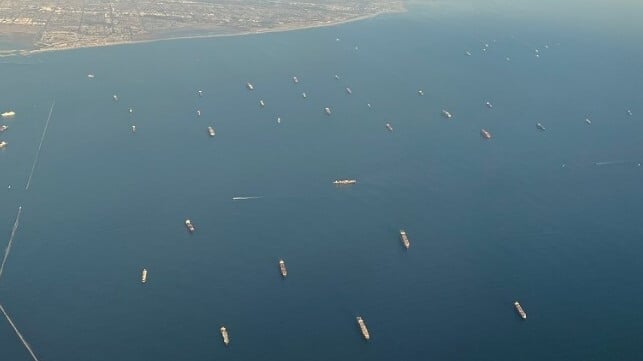Research Confirms Digital Port Queuing System Also Cuts Shipping Emissions

Researchers based in California studied the electronic reservation system established for containerships and have now concluded that the digital port queuing system is low-hanging fruit that can help drastically cut shipping emissions. They are the latest to endorse versions of slow steaming for vessels while warning that ports and liners are clinging to the archaic “first-come, first-served” approach.
The starting point for their research focused on the fact that the commercial shipping industry contributes nearly three percent of global greenhouse gasses (GHG) emissions and approximately two percent of global carbon dioxide (CO2), making it a major accelerator of climate change. The researchers said that while shipping is coming under intense pressure to decarbonize, the industry has failed to utilize a system that is the easiest to implement and which can cut GHG emissions by 16 to 24 percent.
Worldwide, ports continue to rely on the century-old “first-come, first-served” system for ship berthing. Typically, vessels continue to race across the ocean and then line up and idle at ports as they wait to be unloaded. The researchers write that “first-come, first-served” incentivized a practice known as “sail fast, then wait” where vessels rush to reach their destination port to secure a place in the berthing queue. As port congestion around the world has grown, vessels can wait at anchorage or loiter near ports at low speed for hours, days, or even weeks.
In normal times at busy ports like Los Angeles and Long Beach, it was typical to have as many as four vessels backlogged and waiting for a berth. At the heart of the pandemic, the backlog for the Southern California ports ballooned to over 100 vessels and even today major ports around the world still have large backlogs.
The ports of Los Angeles and Long Beach implemented a queuing system in 2022 that assigned predetermined positions when vessels departed their last port of call. Essentially, the system means that containerships get a spot in line based on when they left the last port of call. With their place in line secure, vessels delivering cargo to the ports do not have to rush during their trans-Pacific voyage, giving them the luxury to reduce speed which in effect meant burning less fuel and creating fewer emissions.
The researchers at the University of California believed the system is low-hanging fruit that can have the added benefit of reducing CO2 emissions. The team was able to substantiate this conclusion and make a new case for slow steams after applying a bottom-up emissions model using vessel technical specifications and automatic identification system data from 10,000 voyages by 1,157 containerships across 6.5 years (2017–2023). The voyages represented more than 47 million miles of traffic crossing the Pacific.
By comparing emissions before and after the new queuing system was implemented at Los Angeles and Long Beach, the team observed 16 to 24 percent reductions in emissions per voyage post-implementation. The researchers published their findings in the journal Marine Pollution Bulletin.
“Integrating digital queueing represents a straightforward win within the broader technology and digital transformation initiatives that ports and logistics companies are already pursuing, offering an easy-to-implement solution that could scale globally as ports modernize and streamline their operations to reduce emissions,” said Douglas McCauley, a marine ecologist UC Santa Barbara.
He added that if other ports deploy the system, this could offer a relatively simple pathway for the maritime industry to contribute to emissions reduction efforts. Notably, the system does not require massive investments or time to deploy. At Los Angeles and Long Beach, the world’s ninth busiest port complex, the system was up and running in just one month.
The researchers highlight that additional fine-tuning of the queueing system may yield even bigger climate wins. A case in point is tweaking the system slightly so ships traveled at an average speed of 17 knots instead of 18 knots across the Pacific, something that has the capacity to shave off another approximately 308,000 tonnes of CO2 emissions, translating to an additional nine percent reduction.
